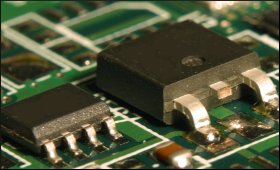|
|
|

|
MoS IT to empower semiconductor startups, next-gen chip designers
|
|

|
|
| Top Stories |
 |
|
|
|
IANS | 09 May, 2023
India's semiconductor market is projected to reach $64 billion by 2026
and Minister of State for Electronics & IT Rajeev Chandrasekhar will
meet and encourage startups, next-generation innovators, chip designers
and business leaders to invest in the semiconductor sector at an event
as part of a series at IIT Delhi on May 12.
The minister
in February inaugurated the 2nd 'Semicon India FutureDESIGN Roadshow'
at IISc in Bengaluru, saying that the country is growing rapidly in
global electronics value chains and rapid growth of digitalisation,
along with the country's high-growth digital and innovation economy, has
created opportunities in the 'New World Order of Semiconductor and
Electronics'.
The first event of this series was held at Karnavati University, Gujarat last year.
At
the Bengaluru event, Chandrasekhar announced the first set of startups
selected under the 'Semicon India Future Design DLI' scheme.
The
scheme aims to offer financial incentives as well as design
infrastructure support across various stages of development and
deployment of semiconductor design(s) for Integrated Circuits (ICs),
Chipsets, System on Chips (SoCs), Systems & IP Cores and
semiconductor linked design(s) over a period of five years.
According
to Prime Minister Narendra Modi, "we have an exceptional semiconductor
design talent pool which makes up to 20 per cent of semiconductor design
engineers".
The IIT Delhi event will focus on innovative
semiconductor designs for automobility, mobility and compute, stimulate
the next generation semiconductor design start-ups, catalyse development
of Indian IP cores in Semiconductors, catalyse co-development and joint
ownership of IPs with active Industry participation and availability of
Incentives for the next wave of design startups.
The Semicon
India Programme, which has an outlay of about $10 billion, funds 50 per
cent of the semiconductor manufacturing project costs with 2.5 per cent
of the budget earmarked for R&D, skill development and training,
according to a report by Invest India, the National Investment Promotion
and Facilitation Agency, India Semiconductor Mission (ISM) and
Counterpoint Research that came out on Tuesday.
The scheme aims
to offer financial incentives as well as design infrastructure support
across various stages of development and deployment of semiconductor
design(s) for Integrated Circuits (ICs), Chipsets, System on Chips
(SoCs), Systems & IP Cores and semiconductor linked design(s) over a
period of five years.
India's semiconductor market was valued at
$22.7 billion in 2019, according to an earlier joint report by
Counterpoint Research and the India Electronics & Semiconductor
Association (IESA).
The 2026 forecast of $64 billion is set to be
driven by both domestic and export markets with significant demand from
the consumer electronics, telecom, IT hardware and industrial sectors.
India's 'telecom stack' and industrial applications are expected to account for two-thirds of the total.
"In
the short term, there is a huge opportunity being driven by domestic
demand across applications like sensors, logic chips and analog
devices," said Tarun Pathak, Research Director at Counterpoint.
"Local
sourcing is already happening in a significant way. It accounted for
around 10 per cent of the overall market in 2022," he added.
According
to Amitesh Kumar Sinha, CEO of ISM and Joint Secretary, MeitY, "India
is committed to becoming a reliable partner in global supply chains and
we are working towards that by framing long-term policies, keeping the
next 25 years in mind."
"More than 70 per cent of the project
costs for semiconductor manufacturing are incentivised by the central
and state governments, of which 50 per cent is funded by the central
government on an upfront basis while the rest is covered by the state
governments," Sinha said.
|
|
|
| |
|
|
|
|
|
|
|
|
|
|
|
|
|
|
| |
| Customs Exchange Rates |
| Currency |
Import |
Export |
US Dollar
|
₹91.25
|
₹89.55 |
UK Pound
|
₹122.85
|
₹118.85 |
Euro
|
₹107.95
|
₹104.3 |
| Japanese
Yen |
₹59 |
₹57.1 |
| As on 29 Dec, 2025 |
|
|
| Daily Poll |
 |
 |
| What is your biggest hurdle to scaling right now? |
|
|
|
|
|
| Commented Stories |
 |
|
|
|
|
|
| |
|